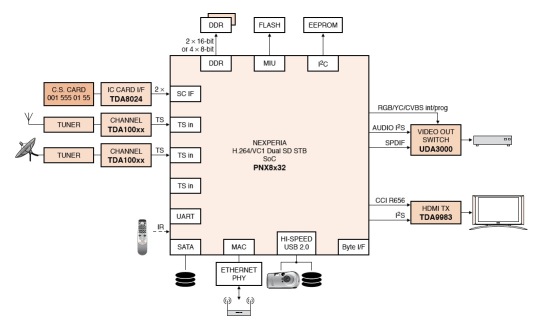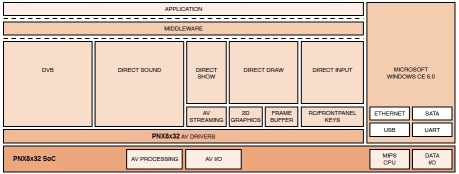IP-STB reference design supports Linux
Mar 20, 2008 — by LinuxDevices Staff — from the LinuxDevices Archive — 18 views NXP has announced an STB (set-top box) development kit that runs Linux and supports SD (standard definition) television. The STB222 has a MIPS32 CPU core, decodes MPEG-4 AVC/H.264 video, reduces MPEG artifacts, and can decode two video streams at once, according to the company.
NXP has announced an STB (set-top box) development kit that runs Linux and supports SD (standard definition) television. The STB222 has a MIPS32 CPU core, decodes MPEG-4 AVC/H.264 video, reduces MPEG artifacts, and can decode two video streams at once, according to the company.
(Click here for a larger view of NXP's STB222 design)
Except for the lack of HD (high definition) 720p/1080i output, the STB222 appears extremely similar to the STB225 announced by NXP last year. NXP says the STB225's PNX8935 SoC is pin- and software-compatible with the STB222's PX8932, easing simultaneous development of SD and HD products.
The STB222 allows hybrid STBs to combine IP (internet protocol) television with terrestrial, cable, or satellite reception. Via its SATA and USB 2.0 interfaces, it allows boxes to be equipped with hard drives, acting as PVRs (personal video recorders). Alternatively, it supports a single stream of SD TV with as little as 64MB of RAM, and can also act as a “low-cost” client for media servers, according to NXP.
The device supports a wide variety of audio and video formats, including MPEG4 AVC (advanced video coding), said to provide good quality video at less than half the bit rate of MPEG-2, H.263, or MPEG-4 Part 2. Noting that MPEG-2, used in DVD and many DVB (digital video broadcasting) formats, will be around for some time, NXP says the STB222 includes “dedicated picture improvements” that reduce blocking and other visible MPEG artifacts.
NXP did not provide physical specifications for the STB222, but the device is built around the company's PNX8932 SoC (system-on-chip), said to combine a MIPS32 processor core with a dedicated audio processor and multi-standard video decoder. The SoC includes a wide variety of interfaces, as seen in the block diagram below. These include Ethernet, USB 2.0, two serial ports, an MIU bus to support flash devices, and a remote control interface.

A block diagram of NXP's PNX8932 SoC
(Click to enlarge)
Dual SD video outputs are supported, with component video (RGB/YUV), S-video, and composite video outputs. The STB222 also offers an optional HDMI interface, for connection to HD displays.
Secure boot, unique ID, and secure key handling are implemented on the STB222, along with decryption standards such as AES, DES, 3DES, DVB-CSA, and Multi2. Other operator specific copy-protection schemes are also available, NXP says.

The STB222 runs Windows CE 6.0 natively, but also supports Linux
(Click to enlarge)
Features and specifications cited by NXP for the STB222 include:
- Processor — PNX8932, with MIPS32 core, plus dedicated audio processor and multi-standard video decoder
- Networking — 10/100 Ethernet
- Other I/O:
- supports 3 digital tuners, 2 active simultaneously
- USB 2.0
- 2 x RS232
- MIU interface for flash
- SATA
- Video:
- component video (RGB/YUV)
- S-video
- Composite video
- HDMI (optional)
- component video (RGB/YUV)
- supports 3 digital tuners, 2 active simultaneously
- Video formats:
- 576i/480i & 576/480p capabilities
- MPEG4 AVC / H.264 high profile level 3,
- VC1 main profile at medium level
- Advanced profile level 1, MPEG-1 and -2 main / high profile,
- MPEG4-ASP level 5,
- DivX 3.11/4/5/6, DV and JPEG
- Audio formats:
- MPEG-1 layer 1&2
- MPEG-4 AAC and AAC-HE
- Dolby Digital AC-3
- MP3
- WMA
- MPEG-1 layer 1&2
The STB222 can support other video codecs without the addition of external DSPs. As an example of this, NXP said the device has been chosen by ChangHong for a forthcoming STB supporting China's home-market AVS (audio video standard).
Further information
The STB222 comes with either the Linux 2.6 kernel or Windows CE 6.0. NXP did not cite pricing and availability information for the STB222. However, the design will be demonstrated at Convergence India in New Delhi from Mar. 19-21. In addition, ChangHong's AVS-compliant set-top box platform will be demonstrated at CCBN 2008 in Beijing, from Mar. 21-23.
This article was originally published on LinuxDevices.com and has been donated to the open source community by QuinStreet Inc. Please visit LinuxToday.com for up-to-date news and articles about Linux and open source.